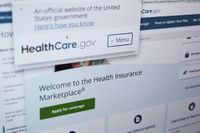As the cost of living continues to climb, Americans across the country are facing tough choices about their health and finances—decisions that could have lasting consequences. Prescription drugs and medical expenses are weighing heavily on both families and the broader health care system, with experts warning that the situation may get even tougher in the year ahead.
According to Family Features, a staggering 27% of Americans are now skipping prescriptions each month due to cost. For many, the price of medication has become a financial burden so significant that one in three people are cutting back on essentials like food or clothing just to afford their prescriptions. This isn’t just a matter of inconvenience; it’s a public health crisis in the making, with long-term risks that could drive up costs even more down the line.
But the crunch isn’t confined to individuals. As reported by the Associated Press, health insurers and employers are also feeling the pressure from rising medical costs, and these increases are set to hit patients directly in 2026. Insurance premiums are expected to jump by around 20% in the Affordable Care Act’s individual coverage marketplaces. Even more worrying, enhanced federal tax credits that help people buy coverage could expire at the end of 2025. If that happens, consumer costs could soar by 75% or more, according to KFF, a nonprofit that studies health care trends.
"We’re in a period of uncertainty in every health insurance market right now, which is something we haven’t seen in a very long time," said Larry Levitt, an executive vice president at KFF. With more people seeking care, emergency room visits on the rise, and a surge in mental health treatment claims, insurers are facing mounting expenses. The cost of prescription drugs—especially popular new treatments for diabetes and obesity like Ozempic, Mounjaro, Wegovy, and Zepbound—has become a particular headache for insurers and patients alike.
Vinnie Daboul, managing director of the employee benefits consultant RT Consulting, put it bluntly: "Pharmacy just gives me a headache, no pun intended." The challenge doesn’t stop with widely used drugs. New gene therapies, which can carry a one-time cost of more than $2 million, are entering the market and driving up costs for everyone, even if only a handful of patients need them. Sun Life Financial, which covers high-cost claims for employers, reported that last year it handled 47 claims topping $3 million each—a dramatic increase from just a handful five years ago, according to Jen Collier, the company’s president of health and risk solutions.
These rising costs are already prompting employers to reconsider how much of the burden they’re willing—or able—to shoulder. Mercer, a leading benefits consultant, found that about half of large employers surveyed are likely to shift more costs to employees in 2026. That could mean higher deductibles, larger out-of-pocket maximums, or changes in what’s covered. Emily Bremer, president of The Bremer Group, an independent insurance agency in St. Louis, noted that while employers aren’t eager to cut benefits, "If something doesn’t give with pharmacy costs, it’s going to be coming sooner than we’d like to think."
Meanwhile, the landscape for coverage itself is shifting. Enrollment in the Affordable Care Act’s insurance marketplaces has swelled in recent years, but a post-pandemic crackdown on fraud and tighter eligibility checks are making it harder for some people to stay covered. As Jefferies analyst David Windley explained, "People who use little care are disappearing," leaving a higher concentration of sicker patients who generate more claims—and thus drive up premiums for everyone else.
For small business owners like Shirley Modlin of 3D Design and Manufacturing in Powhatan, Virginia, these changes are deeply personal. Unable to afford full health benefits for her 20 employees, Modlin reimburses them $350 a month for coverage they purchase themselves. But with premiums rising and the threat of higher costs looming, she worries that her staff may be forced to seek jobs at larger companies that can offer better benefits. "My employee may not want to go to work for a large corporation, but when they consider how they have to pay their bills, sometimes they have to make sacrifices," Modlin said.
Even for those with insurance, the system is becoming more complicated and less predictable. Family Features reports that only about half of all prescriptions are now fully covered by insurance without restrictions. Many plans impose hurdles like step therapy, quantity limits, or prior authorizations, which can delay treatment or increase out-of-pocket costs at the pharmacy counter. As Cindy George, MPH, senior personal finance editor at GoodRx, explained, "Even insured individuals are struggling to keep up with health care costs. More and more are finding themselves underinsured, and that’s making basic health care harder to afford—and harder to access—for millions of families."
One piece of good news: there are strategies and tools available to help consumers navigate these turbulent waters. George points out that prescription costs can vary by upwards of $100 from one pharmacy to the next, even within the same ZIP code. "Many people don’t realize there is no single price for a prescription," she said. Cost comparison tools like GoodRx allow patients to compare prices, explore alternative medications, and sometimes find significant savings, regardless of their insurance status.
But understanding where to find the best price is just one piece of the puzzle. George emphasizes the importance of "health care cost literacy"—knowing how insurance works, what’s included in a plan’s formulary, and how to interpret billing documents. "Improving your health care cost literacy starts with being aware of your options and asking the right questions," she said. Trusted resources, such as the GoodRx Guide to Drug Costs, Coverage and Savings, hospital and insurance plan cost estimators, and State Health Insurance Assistance Programs (SHIPs) for Medicare, can help consumers make informed choices.
Looking ahead to 2026, patients may face even more changes. Insurers are considering new ways to control costs, such as capping coverage for expensive obesity treatments or introducing separate deductibles for pharmaceutical and medical benefits. Some plans may require patients to pay more for their prescriptions, or limit who can access certain high-cost drugs.
As the U.S. health care landscape grows more complex and costly, the message from experts is clear: knowledge and proactive planning are more important than ever. By building cost literacy, comparing prices, and using available tools, consumers can take steps to protect both their health and their wallets—even as the system around them continues to change.
For those feeling overwhelmed, resources like GoodRx.com offer a starting point to explore options, compare prices, and regain some control over ever-rising medication costs. In a time of uncertainty, a little information can go a long way.






